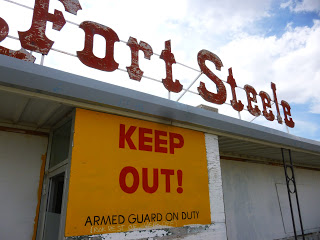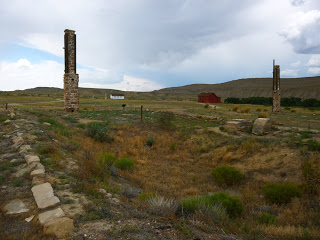By Greg Rasanen
 I always drive past Old Fort Steele, which isn’t much more than a rest stop now. However, on the south side of the highway, is an old gas station that I thought was photogenic in its decay, so this year I stopped to snap a quick photo. As I was snapping the picture, I wondered what the story behind the name was, and as I was pulling back out to the highway I saw the answer in a sign for a historic site.
I always drive past Old Fort Steele, which isn’t much more than a rest stop now. However, on the south side of the highway, is an old gas station that I thought was photogenic in its decay, so this year I stopped to snap a quick photo. As I was snapping the picture, I wondered what the story behind the name was, and as I was pulling back out to the highway I saw the answer in a sign for a historic site.
Fort Steele also traces its origins back to the transcontinental railroad. The military fort was established on the North Platte River, to protect the strategic river crossing and as a supply depot, for receiving military supplies by rail to support other forts throughout the region. It was established in 1868 and abandoned in 1886. The local community took over the buildings primarily supporting the timber and sheep grazing in the area, but it had a second transportation boom in the 1920/30’s with the building of the Lincoln Highway.
Foundations and chimneys are all that remains of two enlisted barracks. They were converted to hotels for Lincoln Highway travelers before vandals burnt them down on New Years Eve 1976.
Troops from the fort protected settlers and the railroad from Indians in the area, and also were dispatched to quell labor riots as far afield as Chicago. They also quelled local labor clashes like the Chinese Massacre in Rock Spring, Wyoming in 1885.
Rock Springs was a coal mining/UP company town and Chinese labor had been brought in to replace white workers because they would work for less. The riots left 28 dead, 15 wounded and 78 homes Chinese homes burned. Local officials and citizens supported the white miners, and not a single person was convicted for the crimes committed. In addition to the Ft Steele troops, there were six companies sent to Wyoming from Utah, and a military camp remained outside Rock Springs until 1899.
LIKE WHAT YOU JUST READ?
- Browse our archive of Historic Places and Spaces Profiles by clicking here.
- To learn about all of our campaigns and initiatives, click here.
- Subscribe to our newsletter to learn more about what’s going on in Wyoming.
- Donate or become a member to help us produce stories, organize events, and be a voice for preservation across the state.
- Like us on Facebook, and follow us on Twitter and Instagram to see our latest updates!
Get new stories directly in your inbox! We’ll only send you an email when a new story is published.




